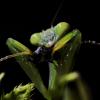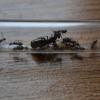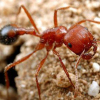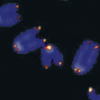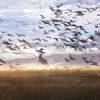Strumigenys trageri
Trager's Arboreal Pygmy Snapping Ant
Description: Strumigenys trageri is the largest member of the cordovensis complex in the Strumigenys mandibularis-group (TL 4.9-5.1). It can be easily separated from other groups of South American Strumigenys by it's enormously elongated mandibles (ML 1.33-1.54)and it's elongated head shape. It's mandibles, like most other species in the cordovensis complex, are highly elongate, with three large preapical teeth. The distal and proximal preapical teeth are far closer together than distance between the proximal preapical tooth and apicodorsal tooth. The eye is enlarged for an arboreal lifestyle. The head is strongly elongated (HL 1.2-1.41). Hairs on the head and alitrunk are sparse and short. Hairs are suberect and spoon-shaped throughout. Hairs on the petiole and postpetiole are elongate and and fine, curving backwards slightly. No hairs are present on the gaster surface, short of a few short, fine hairs near the sting. Spongiform tissue lacking on petiole, reduced to posterior dorsal end of postpetiole. Upper propodeal spines are highly elongated and curve upward, ending in a blunt tip. Lower pair shorter with no curve, also trailing to a blunt tip. The legs are fairly short for a mandibularis-group Strumigenys perhaps due to it's twig nesting behavior.
Distribution: Spread throughout much of North-Western South America, extending up Costa Rica. Holotype series recorded in Ecuador. Unconfirmed records in southern Florida have been described at least twice, though it is unlikely this ant will establish itself in Florida, as the arboreal density of ants seems to be too great for such a small species to take hold for long.
Biology: One of the only arboreal mandibularis-group Strumigenys. The species is common, but was not recorded until only a few years ago, due to it's hard-to-reach nesting sites. Nests seem to mostly occur inside abandoned ant nests at the very tops of rainforest trees, usually nests of Cephalotes or Pseudomyrmex. Nests occasionally occur lower on trees, though the only record was a trio of founding queens with a large batch of eggs and four larva in the first instar. Foraging occurs diurnally, and workers rarely descend more than halfway down the tree. Workers tend to prey on arboreal Collembolans and other small arthropods, but will occasionally accept nectar from flowering plants.
Though the species was only discovered recently, much is known of it's feeding biology. When observed under laboratory conditions, workers tended to ignore small Collembolans, though if a Collembolan wanders into the ant's mandibles, the ant will attack, though Collembolans captured in this manner seem to be ignored and eventually dumped outside the nest. More typical trageri prey was apparently small termites, usually going after Nasutitermes, but occasionally attacking and consuming Constrictotermes. When a termite is detected, workers immediately freeze before moving into a crouched position. If the termite starts moving, the ant will wait until movement has stopped before slowly moving in, mandibles open, trigger hairs exposed. The ant will stop 2 millimeters away from the termite before lunging forward and stunning the termite. If movement in the termite continues, the prey is subdued with a sting, though this is rarely necessary as the mandibles close with such force as to kill the termite nearly instantly, impaling it on the ant's subapical teeth. When stalking springtails, the ants used a similar method to stalking termites, though their movements were sped up as if in a less cautious approach.
Unlike most Strumigenys species, trageri's approach to capturing prey seems to be more visually oriented. This is most likely due to the ant's arboreal habits, forcing the ant to have stronger visual ques.
Etymology: Named for James Trager, an American Myrmecologist most well known for his extensive work done on the revisions of ants in the genera Solenopsis, Nylanderia, Dorymyrmex, Polyergus, along with others.
Picture coming soon!




